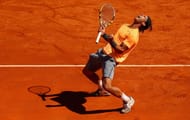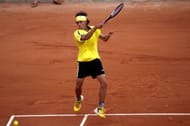Spring is in the air for a tennis fan.
You know it when you browse through the internet and are confronted with visuals of one blinding reddish-orange tennis court after another. You know it when tournament websites offer you options to view content in various European languages. You know it when you see your first image of the Mediterranean sun beating down on the French Riviera and upon the enchantingly located venue of the Monte Carlo Masters. There can be no doubt about it, the European clay swing is underway.
There is a buzz surrounding the beginning of this clay season, as has been the case over the last few years. What is intriguing is that the interest continues to revolve around the same issues as always, but with ever increasing intensity. Are we yet to see the limits of Rafael Nadal on clay? Every successful defence of his Roland Garros crown makes for an increasingly miraculous scenario.
Will Novak Djokovic finally achieve his career objective of a French Open title? Every successive thwarting at the gates by Nadal makes for an increasingly frustrating scenario. Is Roger Federer still a force on clay? Every defeat at the hands of an upcoming upstart makes that an increasingly unlikely scenario.
Compare today’s scene with the ATP picture of the ‘90s and early 2000s; such a narrow focus of topics for tennis debate during the clay season was unthinkable. The questions were more likely to be about which unknown player from Spain or South America would make it big that season, before slipping back into anonymity. It was an age when players at the top of the game (think Pete Sampras) went through the motions on clay, while other more obscure players saw the European spring as their only legitimate season of the year. It was next-to-impossible to come up with storylines that cut across playing surfaces. The cast involved in these storylines were so radically different with minimal overlap. Looking back now, the period around the turn of the millennium saw the best of that eccentric, unpredictable breed of tennis players – the clay court specialists.
But is the specialist dirtballer no longer a force today? Or are we just overwhelmed by the success of the Big 3 in the last decade?
It might help to play the statistics game with players across the generations. To begin with, it would be useful to define a clay court specialist by his results on clay, as opposed to other incidental aspects like technique, strategy, decibel levels, etc. It may thus be reasonable to say that a successful clay court specialist at the top of the professional game is one who has a significant positive difference in match win percentage on clay compared to his all-court figures, who has a significant proportion of tournament wins on clay, and who has been a champion/legitimate contender at Roland Garros. With this in mind, how have clay court specialists fared over the years?
Sergi Bruguera, pioneer of the Spanish tennis armada in the ‘90s, made his name as a 2-time winner of the French Open. He ended up with a 69% win-record on clay, compared to an overall 62% win-record, a significant +7% difference. Moreover, all but one of his 14 titles (93%), came on clay. Bruguera set the generational trend of what could be achieved with a single-minded focus on a single surface.
Thomas Muster would go on to perfect the art of clay specialization, both in terms of success on the particular surface, and his lack of it on others. Muster won 77% of his matches on clay, compared to 69% overall (+8% difference). 40 of his 44 titles (91%) came on clay as well, the biggest being the 1995 French Open. He was conspicuous by his absence on most Wimbledon outings, but that did not prevent him from holding the number 1 ranking in the mid-90s.
Gustavo Kuerten was easily the most dominant, and also most likeable, champion of the immediate pre-Rafa era. The 3-time winner at Roland Garros won 70% of his matches on clay compared to an overall 65% (+5% difference). 14 of his 20 titles (70%) were won on clay. Thus, Kuerten definitely preferred clay, but maybe was not as much of a surface specialist as some of the others.
Definitely not as much as players like Albert Costa and Gaston Gaudio, both French Open winners in the early 2000s. Costa won all his 12 ATP titles (100%) on clay, winning 67% of his clay court matches in the process (+8% difference on overall record). Gaudio’s French Open triumph was one of 8 title victories, all on clay (100%). His 66% win record on clay also boasted of a +8% difference over his overall record.
So 2005, the year immediately following Gaudio’s Roland Garros triumph, seemed to be like any other at the French Open when an unknown Argentine dirtballer, Mariano Puerta, took on a young Spanish debutante finalist in Rafael Nadal. Even when the kid from Mallorca, brought up on clay, proceeded to stake claim to his maiden Grand Slam title, there was nothing to indicate a dramatic shift in trends, except maybe the champion’s young age. How little did we know.
In today’s game, who are the potential clay court specialists, who remain legitimate contenders at Roland Garros? David Ferrer comes to mind, perhaps? But with a clay win record of 72% compared to an overall record of 67% (+5% difference), and with only 11 of his 21 ATP titles (52%) coming on clay, it seems unfair to call him a specialist.
Nadal’s colleagues in the Big 3, neither of whom consider clay their favourite surface, provide interesting counterpoints. Djokovic has a 77% win record on clay, which actually pales in comparison to his overall 81% record (-4% difference). Only a measly 8 of 43 titles (19%) have been achieved on clay for the Serb. Federer’s figures, as one might expect, are even more skewed, winning 76% of his matches on clay, compared to 81% overall (-5% difference), with only 10 of 78 titles achieved on clay (13%).
The interesting point in the statistics of today’s greats is the extremely high clay-court win record they maintain, compared to even the dirtballers of a decade or two ago. To say clay is not one’s best surface despite winning 77% of the time on it, is nothing but an indication of the all-court prowess of the top players today.
For people eagerly looking to identify the next great clay court specialist, it might pay to put your bets on someone like Fabio Fognini. All 3 of his ATP titles so far (100%) have come on clay. He has a +8% difference in win percentage on clay compared to all surfaces. But given that he wins only 58% of his clay-court matches to begin with, and that Fognini himself professes to be an all-court player, this might be too soon to make judgements on his career.

Rafael Nadal of Spain celebrates match point after his straight sets victory against Novak Djokovic of Serbia in the final during day eight of the ATP Monte Carlo Masters, at Monte-Carlo Sporting Club on April 22, 2012 in Monte-Carlo, Monaco..
But what about the great man himself? Rafael Nadal comes in, as one might expect, with some impressive figures. He wins a staggering 93% of his matches on clay, compared to an equally mighty 84% overall (+9 difference). 43 of his 62 titles so far (69%) have come on clay. These facts reinforce what we already know about the man. Nadal is not just any clay-court specialist, he is the greatest ever to play the game on clay. Moreover, an all-surface win record of 84%, supported by 1 in every 3 titles coming in non-clay events, makes a strong case for a very rarefied status for Nadal in the pantheons of the game.
Which brings us to the point that we began with, what should we expect from Nadal this clay season? Any success that he will have will invariably be of an unprecedented nature. But then, his achievements on clay have been unprecedented for a couple of years now.
As we begin another season of watching Nadal rolling through clay, we are actually embarking on another journey into the unknown with the game’s greatest clay court specialist. None of us, including Nadal, know where the destination lies, or where exactly we are expected to get off. No one has done any of this before, and so, no one knows what to expect. And that may be the most fascinating aspect of our relationship with Rafael Nadal and his exploits on clay.
* All statistics are sourced from http://www.atpworldtour.com/
Who Are Roger Federer's Kids? Know All About Federer's Twins

